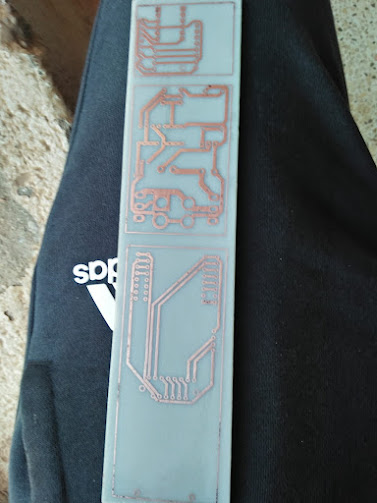REPORT ON STATIC TESTING DONE ON 22ND MARCH 2021
Prep work
This is a summary of the work done in preparation for the static testing.
These activities were:
Fabrication of a test stand- We made a test stand as well as wrote relevant code to measure ,analyze, visualize and store data during testing.
Research work on PVC motors- We did research on PVC motor design. A link to a major resource is attached. Link: https://www.nakka-rocketry.net/pvcmot4.html#Intro
We also developed a remote ignition system by repurposing parts of an old toy car.
Motor Design
1.Propellant
The propellant of choice was Potassium Nitrate(Oxidizer) and Sucrose(Fuel/Binder). An oxidizer to fuel ratio of 65%:35% was used. The propellant was cast into two grains with a total weight of 34g.
The grains had an outside diameter of 24mm and a core diameter of 7.2mm.
Prior to static testing a simulation using openMotor was done for a theoretical performance of the motor.
A link to this data is attached: https://github.com/nakujaproject/felixResearch/blob/main/Motor%20data/Motor150321-01/test%20motor-22-03-2021.ric
A photo of the data is attached
2.Motor Casing
The casing of the motor was made from ¾ inch PVC. The top side(bulk head) as well as the nozzle were to be made from tile cement.
The nozzle was designed with the following dimensions:
Throat diameter - 5 mm
Exit diameter - 5 mm
Throat length - 35mm
Divergence half angle - 0 degrees
Convergence half angle - 0 degrees
The design of the casing was as follows:
Motor Fabrication
The KNSU propellant was cast as follows:
https://www.youtube.com/watch?v=WRfyVkgOjfY
The nozzle and endcap were fabricated using tile cement(grout).
The grout is mixed with water in the ratio 3:1 by weight and poured into the pipe. The cast is left to set overnight. The nozzle is made by drilling the whole with a 5mm drill bit. This resulted in a straight nozzle as designed.
Static Firing
Link to static firing video: https://www.youtube.com/watch?v=amsQHMwb428
Results
From the video it can be seen that the launch was a cato.
Only one grain burnt
The test stand failed
Some data was obtained
Failures
We identified the following as reasons for the cato:
The bulk head was too small- the size of the bulk couldn't withstand the pressure produced during the burning of the grain. This caused ejection of some pieces of the motor from the test stand.
There may have been an air gap between the two grains which caused a pressure build up that resulted in the motor failing
Failed ignition was another concern as the ignition failed three times prior. It was also evidenced by the unburnt motor
The test stand failed causing loss of some data points
Solutions
The propulsion team met and came up with the following solutions:
The use of pvc fitting end caps to counteract the chamber pressure
Using a single grain for the next test and progressively increase the pressure and document material integrity
Develop a new ignition system
Redesign the test stand to avoid failure
Positives
The following were identified as positives from the static firing:
The fuel burnt pretty well with minimal residue resulting in a beautiful flame.
Data collection,visualization and remote reporting were all successful.
The link to data collected is: https://drive.google.com/drive/u/0/folders/1aDTR7Ge0mJxfb7UrkQESp5lbnolo8V0l
The data is graphed to obtain the following:
From the graph it is seen that just before the cato we had an instantaneous thrust of 200g about 2N.This may seem small but it is very promising.
The remote ignition mechanism was successful.
None of the members were injured during the firing.
Conclusion
As with every test lessons are learnt. The first static firing of cast propellant was full of lessons that will aid the development of the N1 rocket motor as well as its refinement. The progress made was substantial and we look forward to many successful launches from this first failed one.



Comments
Post a Comment